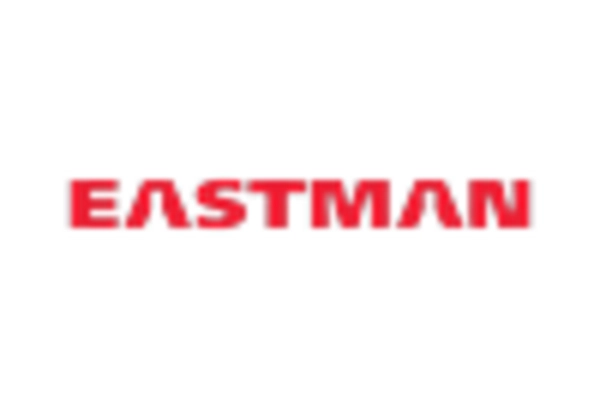The glycol market exhibits a dynamic competitive landscape characterized by a blend of innovation, strategic partnerships, and regional expansion. Key players such as Dow Inc. (US), BASF SE (DE), and Eastman Chemical Company (US) are at the forefront, each employing distinct strategies to enhance their market positioning. Dow Inc. (US) focuses on sustainability and digital transformation, aiming to reduce its carbon footprint while optimizing production processes. BASF SE (DE) emphasizes innovation through research and development, particularly in bio-based glycols, which aligns with the growing demand for sustainable products. Eastman Chemical Company (US) is actively pursuing strategic partnerships to bolster its supply chain resilience and expand its product offerings, thereby enhancing its competitive edge.
The market structure appears moderately fragmented, with several players vying for market share. Key tactics such as localizing manufacturing and optimizing supply chains are prevalent among these companies, allowing them to respond swiftly to regional demands and fluctuations in raw material prices. The collective influence of these major players shapes the competitive environment, fostering a landscape where agility and responsiveness are paramount.
In October 2025, Dow Inc. (US) announced a significant investment in a new production facility aimed at increasing its capacity for sustainable glycol production. This strategic move is likely to enhance Dow's ability to meet the rising demand for eco-friendly products, positioning the company as a leader in sustainability within the glycol market. The investment underscores Dow's commitment to innovation and aligns with broader industry trends towards greener alternatives.
In September 2025, BASF SE (DE) launched a new line of bio-based glycols derived from renewable resources. This initiative not only reflects BASF's dedication to sustainability but also addresses the increasing consumer preference for environmentally friendly products. The introduction of bio-based options may potentially reshape market dynamics, as competitors may need to adapt their offerings to remain relevant in a rapidly evolving landscape.
In August 2025, Eastman Chemical Company (US) entered into a strategic partnership with a leading technology firm to enhance its digital capabilities in production and supply chain management. This collaboration is expected to streamline operations and improve efficiency, allowing Eastman to respond more effectively to market demands. The integration of advanced technologies could provide Eastman with a competitive advantage, particularly in an environment where digitalization is becoming increasingly critical.
As of November 2025, current trends in the glycol market are heavily influenced by digitalization, sustainability, and the integration of artificial intelligence. Strategic alliances are playing a crucial role in shaping the competitive landscape, enabling companies to leverage shared resources and expertise. Looking ahead, it appears that competitive differentiation will increasingly hinge on innovation and technology rather than solely on price. Companies that prioritize sustainable practices and invest in advanced technologies are likely to emerge as leaders in this evolving market.

















Leave a Comment